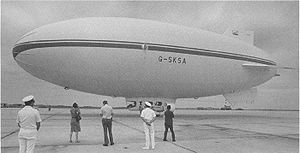SkyShip 500
SkyShip 500 / AD 500 was a type of impact airship that first rose in 1981.
history
After the loss of R101 and the scrapping of R100 in the early 1930s, the British airship industry was quiet for around 50 years. Despite various plans and projects, it was not until 1979 that an airship took to the skies again - the AD 500. It was the prototype of a completely new airship series. Roger Munk, an engineer and designer from the maritime sector, was working for the Shell Group on a large impact airship for gas transport. This project didn't get beyond the drawing board, however. Even so, Roger Munk saw applications for airships that could not be met by airplanes or helicopters.
The development of the AD 500, the prototype of the SkyShip 500 series , began as early as 1976 . For this purpose, the company Airship Developments was founded, which later became Airship Industries before being taken over by Westinghouse Airship Industries - now part of today's Global Skyship Industries, Inc.
In 1979 the prototype was presented. Modern materials and technologies were used in development from the very beginning.
- Length: 52.0 m
- Diameter: 15.2 m
- Gas envelope volume: 5139 m³
- Drive power: 304 kW
- Maximum speed: 90 km / h , (70 mph)
- Payload: 900 kg
drive
A prominent feature for this airship was the thrust vector control . The jacketed propellers could be swiveled a total of 200 degrees up and down, resulting in very good maneuverability and allowing a smaller ground crew. The sheathing reduced the noise level and reduced the risk for people on the ground to come into contact with the propellers.
The two Porsche 930 engines were located inside the gondola behind the passenger compartment and were connected to the propellers via drive shafts.
gondola
The gondola was largely made of aramid fiber reinforced plastic . Their simple, robust construction not only made production easier, but also allowed flexibility in design and required little maintenance. It hangs on 14 aramid ropes and is also secured against horizontal movements. Your weight is distributed over four parabolically curved belts that are attached to the case.
The cabin can accommodate a maximum of nine passengers and three crew members. The windows can be opened for a better view. The pilot had an undisturbed view of almost 180 degrees through the large windshield.
Although the ship was designed to be controlled by a pilot, there were two cockpit seats. The movement of the tail surfaces was carried out via the double controls, there were no pedals, as is usual in conventional aircraft. The motors were operated via simple levers in the middle of the control console.
In March 1978, all major components were in Hangar No. 1 assembled in Cardington . The rigid airship R100 had already been built in this hall around 50 years earlier . There were delays in the construction of AD 500, so that the original date of the maiden voyage had to be postponed. A buyer for the new ship had also already been found and so they wanted to make sure that the new development fulfilled all expectations. The AD 500 prototype made its first run on February 3, 1979.
Calls
The prototype only existed for a short time. AD 500 was destroyed by a storm on March 8, 1979 in Cardington, lying at the anchor mast , after only one month . It had not been possible to get the ship into the airship hangar beforehand . The hull was opened with the emergency ripcord to let the gas escape before the ship was completely destroyed. All was not lost, however. The ship had already proven its suitability and a short time later the first orders came, which soon led to the construction of the first Skyship 500.
Six SkyShip 500s were built from 1980 to 1990. They were not only used for advertising, but also for passenger tours and monitoring tasks. In 1983 a charter contract for an airship was signed for the first time. This ship was delivered to sponsor Fuji in March 1984 . On July 28 of this year, the SkyShip 500-05 was sold to Japan Airship Services (JAS), a division of Japan Airlines . It was the first full sale of a Skyship 500. Later, additional copies were sold to JAS, the Korean government and the Tokyo Police Department for surveillance.
In 1984, the Olympic Games in Los Angeles were used for demonstration purposes when the ship chartered by Fuji greeted the guests with “Welcome” on its hull. The same ship (G-BIHN) was also seen in the James Bond film In the Face of Death (original title "A view to a kill").
The successor model of the SkyShip 500 is called SkyShip 600 .
Ships built
In 1988 five Skyship 500 were in operation.
- 500-02, G-BIHN, base: Cardington / England, first run: September 1981
- 500-03, G-SKSA, base Weeksville / USA, first run: April 1983
- 500-04, (HL), G-SKSC, base: Paris / France, first run: March 1984
- 500-05, JA - 1003, base: Tokyo / Japan, first trip: May 1984
- 500-06, G-SKSH, based on: Touring / USA, first run: August 1985
The abbreviation HL stands for the "heavy lift" version. In this modification, a SkyShip 500 gondola was mounted on a SkyShip 600 hull. In this way, 30% more lift was gained, which among other things made it possible to increase the range.
See also
literature
- JK Bock, B. Knauer: Lighter than air. Transport and carrier systems. Verlag Frankenschwelle, Hildburghausen 2003, ISBN 3-86180-139-6 .
Web links
- aht.ndirect.co.uk/.../ss500 Skyship 500 at airshipsonline (engl.)
